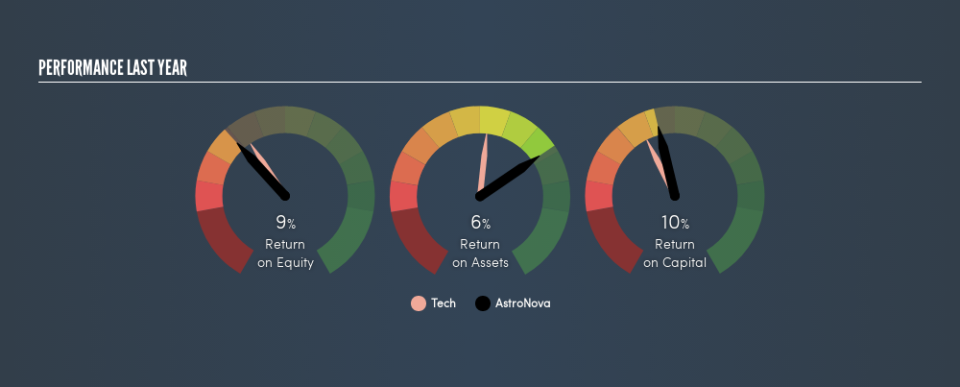Is There More To AstroNova, Inc. (NASDAQ:ALOT) Than Its 10% Returns On Capital?

Today we'll look at AstroNova, Inc. (NASDAQ:ALOT) and reflect on its potential as an investment. Specifically, we're going to calculate its Return On Capital Employed (ROCE), in the hopes of getting some insight into the business.
Firstly, we'll go over how we calculate ROCE. Then we'll compare its ROCE to similar companies. Finally, we'll look at how its current liabilities affect its ROCE.
What is Return On Capital Employed (ROCE)?
ROCE measures the 'return' (pre-tax profit) a company generates from capital employed in its business. Generally speaking a higher ROCE is better. In brief, it is a useful tool, but it is not without drawbacks. Author Edwin Whiting says to be careful when comparing the ROCE of different businesses, since 'No two businesses are exactly alike.'
So, How Do We Calculate ROCE?
The formula for calculating the return on capital employed is:
Return on Capital Employed = Earnings Before Interest and Tax (EBIT) ÷ (Total Assets - Current Liabilities)
Or for AstroNova:
0.10 = US$9.9m ÷ (US$118m - US$22m) (Based on the trailing twelve months to May 2019.)
Therefore, AstroNova has an ROCE of 10%.
See our latest analysis for AstroNova
Is AstroNova's ROCE Good?
When making comparisons between similar businesses, investors may find ROCE useful. We can see AstroNova's ROCE is around the 9.4% average reported by the Tech industry. Aside from the industry comparison, AstroNova's ROCE is mediocre in absolute terms, considering the risk of investing in stocks versus the safety of a bank account. Investors may wish to consider higher-performing investments.
You can see in the image below how AstroNova's ROCE compares to its industry. Click to see more on past growth.
Remember that this metric is backwards looking - it shows what has happened in the past, and does not accurately predict the future. ROCE can be deceptive for cyclical businesses, as returns can look incredible in boom times, and terribly low in downturns. ROCE is, after all, simply a snap shot of a single year. What happens in the future is pretty important for investors, so we have prepared a free report on analyst forecasts for AstroNova.
How AstroNova's Current Liabilities Impact Its ROCE
Short term (or current) liabilities, are things like supplier invoices, overdrafts, or tax bills that need to be paid within 12 months. Due to the way ROCE is calculated, a high level of current liabilities makes a company look as though it has less capital employed, and thus can (sometimes unfairly) boost the ROCE. To counter this, investors can check if a company has high current liabilities relative to total assets.
AstroNova has total liabilities of US$22m and total assets of US$118m. As a result, its current liabilities are equal to approximately 19% of its total assets. This is a modest level of current liabilities, which would only have a small effect on ROCE.
Our Take On AstroNova's ROCE
If AstroNova continues to earn an uninspiring ROCE, there may be better places to invest. Of course, you might also be able to find a better stock than AstroNova. So you may wish to see this free collection of other companies that have grown earnings strongly.
If you like to buy stocks alongside management, then you might just love this free list of companies. (Hint: insiders have been buying them).
We aim to bring you long-term focused research analysis driven by fundamental data. Note that our analysis may not factor in the latest price-sensitive company announcements or qualitative material.
If you spot an error that warrants correction, please contact the editor at editorial-team@simplywallst.com. This article by Simply Wall St is general in nature. It does not constitute a recommendation to buy or sell any stock, and does not take account of your objectives, or your financial situation. Simply Wall St has no position in the stocks mentioned. Thank you for reading.

